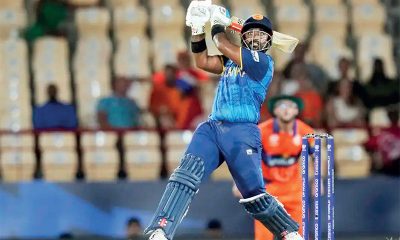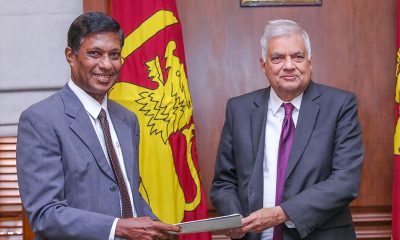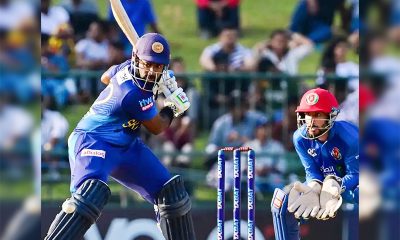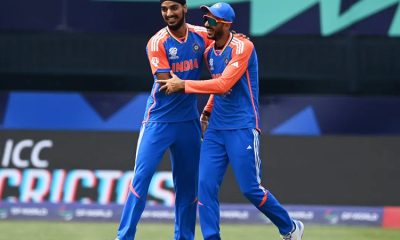Sports
Hannibal was brought in for Palliyaguruge due to fatigue
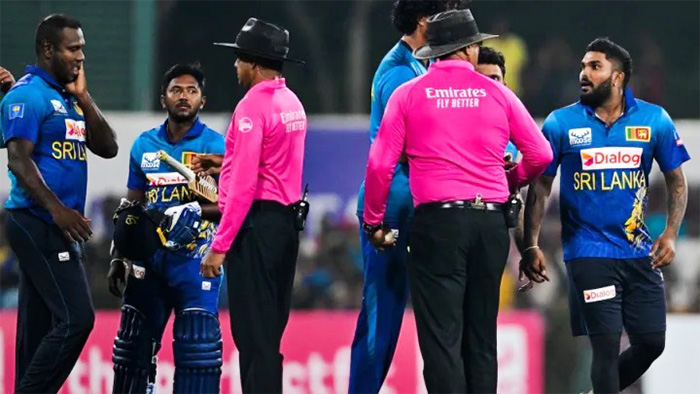
by Rex Clementine
Umpire Lyndon Hannibal has become a marked man with plenty of criticism placed at his doorstep after he failed to detect a no ball in the tensed third T-20 International between Sri Lanka and Afghanistan on Wednesday at Dambulla.
Hannibal was the on-field umpire in the third T-20 International and he was at square leg when he failed to call a no ball for a waist high full toss.
There was disappointment expressed by the Sri Lankan team, coaching staff and fans as the delivery to Kamindu Mendis was not just waist high but chest high.
Captain Wanindu Hasaranga took on the umpire after the game and the match officials notified the Match Referee Chris Broad about a Code of Conduct violation resulting in Hasaranga being banned for two games and fined 50 percent of his match fee. The player accepted the sanctions.
One bad decision certainly doesn’t make someone a bad umpire. However, in domestic cricket and high-profile school games like the Royal – Thomian too Hannibal is known for his howlers.
While Hannibal might struggle to get an international game in the near future with the captain’s report and Match Referee’s observations expected to be against him, it remains to be seen what action SLC will take.
SLC Umpires Committee head Bandula Dissanayake told The Island that Hannibal was made on field umpire only because the authorities were not sure whether Ruchira Palliyaguruge was physically fit to stand in the game.
Dissanayake, a veteran cricket administrator said that Palliyaguruge, Sri Lanka’s most experienced and decorated umpire after Kumar Dharmasena, had arrived in the island only the night before the game following an international assignment and it was felt that he will be better off doing third umpire’s duty rather than on field duty.
“There is very little SLC could do in this regard. The captain’s report directly goes to the ICC and we would not have any source document to follow up the incident,” Dissanayake said when asked what action the Umpires’ Committee will take.
“But this is something that has taken the attention of everyone and obviously it will be discussed at the next umpires’ committee meeting,” he added.
Sri Lanka had won the one-off Test match and swept the ODI series 3-0 and had taken an unassailable 2-0 lead in the three match T-20 series. A win on Wednesday would have enabled them to sweep the T-20s as well.
Although Hannibal has copped a fair share of blame for his handling of the game, Sri Lanka had none but themselves to blame for the defeat with dropped catches, sloppy fielding and the strike bowler spraying all over sending down ten wides.
Latest News
NOC issue, fixture clash put Mustafizur’s IPL participation in doubt

Delhi Capitals’ (DC) signing of Bangladesh fast bowler Mustafizure Rahman for the remainder of IPL 2025 has hit a snag, with the BCB stating that it hasn’t been approached for a no-objection certificate (NOC).
Usually, the IPL only announces signings after a player has received an NOC from his home board. According to its CEO Nizamuddin Chowdhury, however, the BCB had yet to receive a request for one.
“Mustafizur is supposed to go with the team to the UAE according to the schedule,” Chowdhury told ESPNcricinfo on Wednesday. “We have not received any communication from IPL officials. I have also not received any such official communication from Mustafizur either.”
Mustafizur is part of the Bangladesh T20I squad that is due to play back-to-back away T20I series against UAE and Pakistan, both of which clash with the IPL. On Wednesday, hours after the IPL announced his signing as a replacement for Jake Fraser-McGurk, Mustafizur flew out to Dubai with the rest of Bangladesh’s squad.
Bangladesh are due to play two T20Is in the UAE on May 17 and 19, followed by five in Pakistan on May 25, 27 and 30, and June 1 and 3. Those two series are in conflict with the IPL; DC are set to play their last three league matches on May 18, 21 and 24, followed by the playoffs should they get there.
ESPNcricinfo has sought a response from DC on this development.
[Cricinfo]
Sports
Aruna in race to recover before Asian Championships

Sprinter Aruna Dharshana who is undergoing treatments for an injury he sustained during the World Relays, is racing against time to recover for the Asian Athletics Championships which will be held in South Korea later this month.
The 400 metres specialist is one of the two sprinters slated to compete in the one lap race. He is also a key member of the men’s 4×400 metres and 4×400 metres mixed relays alongside Kalinga Kumarage.
“Currently Dharshana is undergoing treatments. We are hopeful that he will recover in time for the Asian Championships,” Dharshana’s coach Asanka Rajakaruna told ‘The Island’.
“Sri Lanka Athletics will conduct a fitness test before the Asian Championships. Hopefully he will be ready by that time,” said Rajakaruna.
Sri Lanka Athletics earlier said that a fitness test will be held to assess the strength of the 20 strong team selected for the biennial event.
Sri Lanka fielded only a mixed relay team for the recently held World Relays in Guangzhou, China where an injury to Dharshana cost them a chance to achieve a top performance and a probable ticket to the World Championships in Tokyo later this year.
Sri Lanka won a historic gold medal in the men’s 4×400 metres at the last edition of the Asian Athletics Championship in Bangkok Thailand where the team inclusive of Dharshana beat India to the second place with a new championship record time of 03:01.56 seconds.
Kalinga Kumarage who did the anchor leg and Dharshana are the only members from that gold winning team selected for the upcoming event.
Dharshana is the only Sri Lankan athlete to have clocked sub 45 seconds in the 400 metres after legendary Sugath Thilakaratne.
Dharshana and Kumarage hold the second and third places respectively in the list of fastest times achieved in the 400 metres by Sri Lankan athletes. Dharshana has a personal best of 44.99 seconds achieved during the last Olympic games.
by Reemus Fernando
Sports
Dinara bags second title

110th Colombo Championships
Dinara de Silva bagged her second title of the Colombo Championships as she partnered Inuki Jayaweera to record straight sets victory in the women’s doubles final played at the Sri Lanka Tennis Association clay courts on Wednesday.
Dinara and Inuki beat Venuli Jayasinghe and Sandithi Usgodaarachchi 6-2, 6-3 in the doubles final.
Incidentally, it was the second title of the tournament for both Dinara and Inuki.
While Dinara won the women’s singles and doubles titles, Inuki was the winner of the mixed doubles and the women’s doubles.
Women’s doubles results
Semi-finals
Dinara de Silva and Inuki Jayaweera beat Dulkini Ranasinghe and Tania Doloswala 6-3, 6-2
Venuli Jayasinghe and Sandithi Usgodaarachchi beat Bovindee Imihamy and Siyara Devappriya 6-3, 6-0.
Quarter-finals
Venuli Jayasinghe and S. Usgodaarachchi beat Tuvini de Alwis and Hasali Gajaba 6-4, 5-7, 10-3.
Dinara de Silva and Inuki Jayaweera beat Nimasha Shehara and Arushi Thomas 6-1, 6-3.
Dulkini Ranasinghe and Tania Doloswala beat Diyansa de Silva and Lihini Jayakody 4-6, 6-3, 10-6.
Bovindee Imihamy and Siyara Devappriya received a walkover from Gehansa Methnadi and Akeesha Silva.
-

 Features4 days ago
Features4 days agoSAITM Graduates Overcome Adversity, Excel Despite Challenges
-

 News4 days ago
News4 days agoDestined to be pope:Brother says Leo XIV always wanted to be a priest
-

 Sports4 days ago
Sports4 days agoASBC Asian U22 and Youth Boxing Championships from Monday
-

 Opinion4 days ago
Opinion4 days agoDrs. Navaratnam’s consultation fee three rupees NOT Rs. 300
-

 Foreign News5 days ago
Foreign News5 days agoMexico sues Google over ‘Gulf of America’ name change
-

 Features3 days ago
Features3 days agoChampioning Geckos, Conservation, and Cross-Disciplinary Research in Sri Lanka
-

 Business4 days ago
Business4 days agoDilmah – HSBC future writers festival attracts 150+ entries
-

 Business4 days ago
Business4 days agoBloom Hills Holdings wins Gold for Edexcel and Cambridge Education



